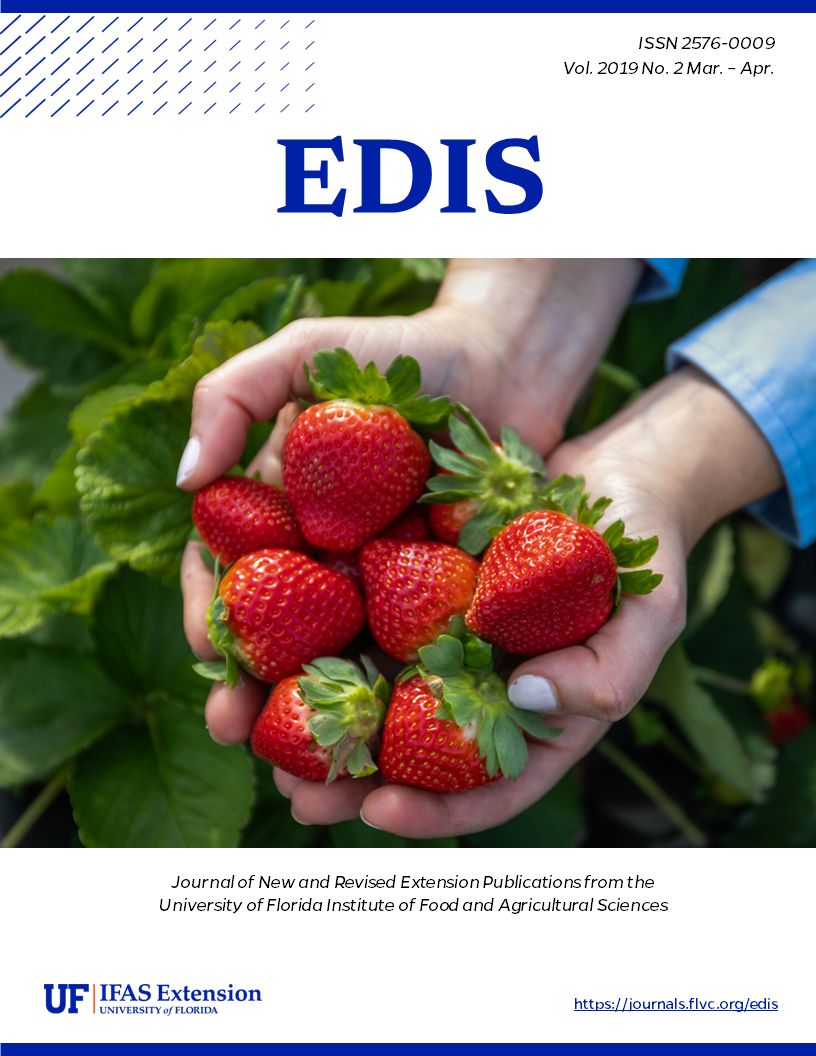Abstract
Praying mantids are charismatic insects that are considered beneficial to humans because of their insectivorous lifestyle and because of their aesthetic appeal. Despite this, many praying mantid species remain understudied. One species that occurs in the southeastern United States is the grass-like mantid, Thesprotia graminis (Scudder) (Figure 1). This small, cryptic mantid species is light brown to green in color and can easily blend in with pine needles and grass, making it difficult to detect in its natural habitat.
Although this mantid may be mistaken for a stick insect (Order: Phasmatodea), especially when its forelegs are held directly in front of the body and it resembles a blade of grass, the raptorial forelimbs reveal the insect’s true identity. There are 14 Neotropical species within the genus Thesprotia, all of which occur in South America except Thesprotia graminis (Rondon et al. 2007). The type specimen for this species is a male that was collected in Gainesville, Florida. It is vouchered in the entomology collection of the Academy of Natural Sciences in Philadelphia, Pennsylvania.
This document is also available on the Featured Creatures website at http://entnemdept.ifas.ufl.edu/creatures/.
References
Costa-Pereira R, Martins FI, Sczesny-Moraes EA, Brescovit A. 2010. Predation on young treefrog (Osteocephalus taurinus) by arthropods (Insecta, Mantodea and Arachnida, Araneae) in Central Brazil. Biota Neotropical 10: 469-472. https://doi.org/10.1590/S1676-06032010000300042
Helfer JR. 1953. How to Know the Grasshoppers, Cockroaches, and their Allies. WM. C. Brown Company Publishers: Dubuque, IA.
Holwell GI. 2006. Spermatophore feeding and mating behavior in praying mantises (Mantodea: Liturgusidae). Journal of Zoology 271: 255-260. https://doi.org/10.1111/j.1469-7998.2006.00263.x
Hughes-Schrader S. 1953. Supplementary notes on the cyto-taxonomy of mantises (Orthoptera: Mantoidea). Chromosoma 6: 79-90. https://doi.org/10.1007/BF01259932
Patel S, Singh G, Singh R. 2016. A checklist of global distribution of Liturgusidae and Thespidae (Mantodea: Dictyoptera). Journal of Entomology and Zoology Studies 4: 793-803.
Peck SB, Beninger C. 1989. A survey of insects of the Florida Keys: Cockroaches (Blattodea), mantises (Mantodea), and walkingsticks (Phasmatodea). Florida Entomologist 72: 612-617. https://doi.org/10.2307/3495035
Preston-Mafham K. 1990. Grasshoppers and mantises of the world. Blandford: London.
Rehn JAG, Hebard M. 1904. The Orthoptera of Thomas County, Georgia, and Leon County, Florida. Proceedings of the Academy of Natural Sciences of Philadelphia 56: 774-802.
Rehn JAG, Hebard M. 1914. On the Orthoptera found on the Florida Keys and in extreme southern Florida. II. Proceedings of the Academy of Natural Sciences of Philadelphia 66: 373-412.
Rehn JAG, Hebard M. 1914. Records of Dermaptera and Orthoptera from west central and southwestern Florida, collected by William T. Davis. Journal of the New York Entomological Society 22: 96-116.
Rivera JA. 2010. A historical review of praying mantis taxonomy and systematics in the Neotropical region: State of knowledge and recent advances (Insecta: Mantodea). Zootaxa 2638: 44-64. https://doi.org/10.11646/zootaxa.2638.1.3
Rondon AAA, Lombardo F, Jantsch LJ. 2007. Checklist of the Neotropical mantises (Insecta, Dictyoptera, Mantodea) Biota Colombiana 8: 105-158.
Scudder SH. 1877. The Florida Orthoptera collected by Mr. J.H. Comstock. Proceedings of the Boston Society of Natural History 19: 80-94.
USA Mantis. Grass mantis (Thesprotia graminis). Photo retrieved from: http://usamantis.com/grassmantis_photo.html
Whitfield JB, Purcell III AH. 2014. Daly and Doyen's Introduction to Insect Biology and Diversity, 3rd Ed. Oxford University Press: New York, NY.
Yager DD. 1990. Sexual dimorphism of auditory function and structure in praying mantises (Mantodea; Dictyoptera). Journal of Zoology 221: 517-537. https://doi.org/10.1111/j.1469-7998.1990.tb04017.x
Unless otherwise specified, articles published in the EDIS journal after January 1, 2024 are licensed under a Creative Commons Attribution-NonCommercial-NoDerivs 4.0 International (CC BY-NC-ND 4.0) license.

